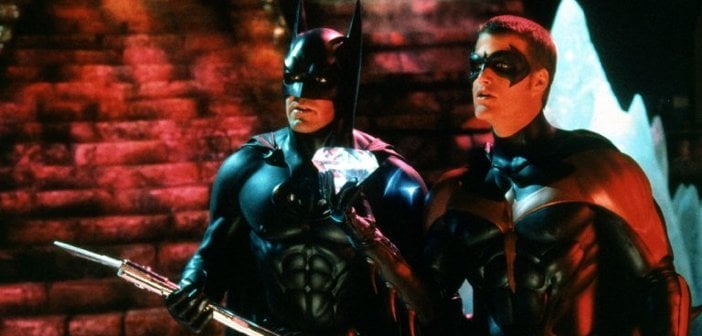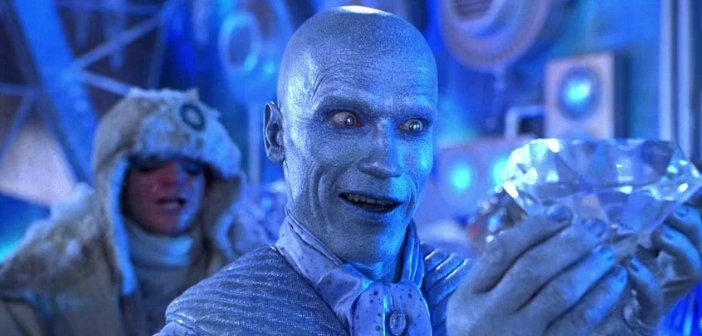20 Years On: How Batman & Robin Killed a Franchise
“A city of justice, a city of love, a city of peace, for everyone of us. We all need it, can’t live without it…Gotham City…” sang R. Kelly some twenty years ago, extolling the virtues of what Bruce Wayne’s fictional hometown could be, if we all just rallied together to make it a better place. If only such a cheerful community spirit had gone into Batman & Robin, instead of wrong-headed executive throttling.
Seen by many as the ultimate example of Hollywood getting a superhero franchise wrong, it’s not hard to see why. For many, it is the benchmark, the forbidden fruit of excess that clueless executives would love to sink their teeth back into. But twenty years later, is it really the worst superhero film ever? Is it even the worst Batman film ever?
It is hard to believe how much of an about-turn the Batman series took from the nightmarish noir-pantomime of Burton’s films (which were sillier and cheesier than their fans care to remember – cast your memory back to DJ Bruce Wayne scratching a CD soundboard of Danny DeVito rants) to the straightforward cartoon of Batman Forever. Had the word ‘reboot’ (soft or hard, however you like it) existed in 1995 it’s likely Forever would have been labelled as such. While there is plenty to suggest that the film is connected to the previous two — some actors return, and throwaway lines refer to Catwoman and the Joker — there’s just as much evidence to suggest that this is a whole new Gotham City for the mid-90s. The sets are bigger, the lights are brighter and the outfits are crazier. Where Anton Furst went for a kind of disgusting, decrepit industrialism that would make even the most contemporary American president blush, Barbara Ling went for neon, day-glo insanity that made Gotham City look like a retro 1950s comic doused in Monster Energy Drink.

Still, Batman Forever is a far better film than people give it credit for. It possibly even extols the virtues of Joel Schumacher as a Bat-Director. For better or worse, Batman Forever is far more akin to the kind of ‘business-as-usual’ superhero things that come out in 2017 — Batman does a lot of brooding, some friends become enemies, some enemies become friends, some frenemies make jokes, Val Kilmer kisses Nicole Kidman (who is almost a character), a few flashbacks enrich Batman’s origin and the day is saved. It holds up not only as a solid action adventure, it does a far better job of making Batman himself the main character (something none of the original four films were very good at) and it even makes Robin kind of cool. All of this is helped by the fact that Val Kilmer, while probably not a better actor than Michael Keaton, is given far more of a physicality as the most caped of crusaders (Keaton shuffled around awkwardly like Jason Voorhees in most of his fight scenes). While the Two-Faced Tommy Lee Jones is left with little to do, 1995’s Jim Carrey, who was paid a whopping 25 million dollars for his troubles, feasts on scenery like a gluttonous Roman monarch. It’s a good time at the movies. Batman & Robin, however, is not.
While watching the first twenty minutes just recently, my abiding consideration was “Well actually this isn’t bad.” Yes, the Batsuit, the Batmobile, and the Dad-like, bobble-headed George Clooney are ill-advised elements from the outset, but ultimately it feels like the opening of a typical Batman adventure, wherein Batman and Robin must go and do a bit of superheroing when a local snow-themed villain is causing problems at the Gotham City Museum of Natural History. The production design is also really strong in Batman & Robin as it was in the previous film. Unlike the syrupy, CGI-soaked fantasy lands of the modern DC films, every location in the Gotham of 1997 is tangible and real and, unlike many bad comic book movies rushed into production, it is still clear that every penny was put on screen to make the scenes look epic.
The problems start when characters open their mouths and words come out. With dialogue like “This is why Superman works alone,” “Hi Freeze, I’m Batman” (delivered with all the gusto of a 6 year old in a St. Attracta’s Nativity Play by eventual Oscar-champion George Clooney) and “You are not sending me to the cooler” (by the Governator himself, in his only return to villainy to date since the original Terminator made him a star). Academy Award-winning screenwriter Akiva Goldsman’s script for Batman & Robin is not one that best displays his talents. Almost every line of overcooked dialogue in this film speaks to how little Schumacher or the producers wanted this to be a real film anymore. This is particularly shameful, given how notably underwritten the Burton films were (more on that next week, Gothamites). Tellingly, Schumacher himself has admitted that before takes, he would remind the actors that “This is a cartoon!”

With the arrival of Uma Thurman’s Poison Ivy in the second act, it becomes abundantly clear that Batman & Robin is trying to emulate the 1966 Adam West TV show, and that she is trying to pay tribute to Julie Newmar’s Catwoman. However, unlike the razor-sharp deadpan wit of the humour in that series, this film only seems to recall the saucy double-entendres and the outrageous sound-effect bubbles that would pop up on screen (the film mercifully doesn’t recreate those, but it does employ the most grating Looney Tunes fight sound effects). Also, George Clooney ain’t no Adam West. Thurman is delightfully sexy in a couple of scenes, but she’s embarrassing enough in others that the mood is spoiled. Her ‘chemistry’ with co-villain Arnie (“I’ll grab your rocks!” — actual dialogue) does nothing for the film.
According to Joel Schumacher, it was a question of time and money. Warner Brothers wanted to pump out Batman films with greater regularity, so they fast-tracked the production of ‘Batman IV’ (or ‘Batman Forever 2’) resulting in a film that followed roughly the same beats, but had none of the polish. But this doesn’t entirely carry water (or ice, as should be the case with a film that contains so much of it). Batman & Robin is not simply a bad film out of carelessness or a lack of filmmaking skill — Batman & Robin is the kind of bad that displays a level of craftsmanship that suggests the film truly was meant to be this way. It’s an ill-informed disaster that fails the characters, the audience, the filmmakers and the 1990s. This resulted in a film so legendarily terrible that Schumacher himself apologised for it on the 2005 special edition release, as well he should. It’s hard to tell who exactly took their eye off the ball, but his apology was appreciated.
It really isn’t all bad though. While the dialogue, the designs and the attitude of the film is all wrong, it must be said that the film at least adheres to Batman’s nobler traits. I saw the film as an eight-year old and truth be told, I loved it. Batman does plenty of good in this film by punching bad guys, but he also learns how to work better with his teammates and even manages to inspire a villain into becoming a friend by the end of the film. Take the line: “Vengeance isn’t true power. Anyone can take a life. Giving life is true power, the power you once had.” This is a nice idea and a far more convincing display of heroic empathy than a roided-up Batfleck deciding not to kill Clark Kent because their Mums have the same name. For all intents and purposes, Batman & Robin succeeds at being the film it sets out to be. Batman V Superman does not, on any level. Make no mistake, I consider Batman V Superman: Dawn of Justice is the worse Batman film of the two and the worst superhero film of all time.
[arve url=”https://www.youtube.com/watch?v=4RBXypX4qWI” maxwidth=”750"]
If nothing else, the legacy of Batman & Robin must also count for something. The film was unleashed in the days when the internet was beginning to gain its foothold over conversation and culture, and when the fanboys lashed out at this film’s inadequacy, the executives listened. Warner Brothers hit the brakes on “Batman Triumphant” and scrambled to find a new direction for their prized money-spinner. After many setbacks — including a proposed Darren Aronofsky-directed origin film where a penniless Bruce Wayne was raised by a streetwise mechanic named ‘Big Al’ — finally the franchise lay at the feet of a promising young director named Christopher Nolan.
Without chaos, there is no order. Without Batman & Robin, there would be no The Dark Knight. While Dawn of Justice suggests a new fall from grace, I’m confident that the Dark Knight will rise again. Hopefully without visible nipples or the need to remind us of his parents’ names.

